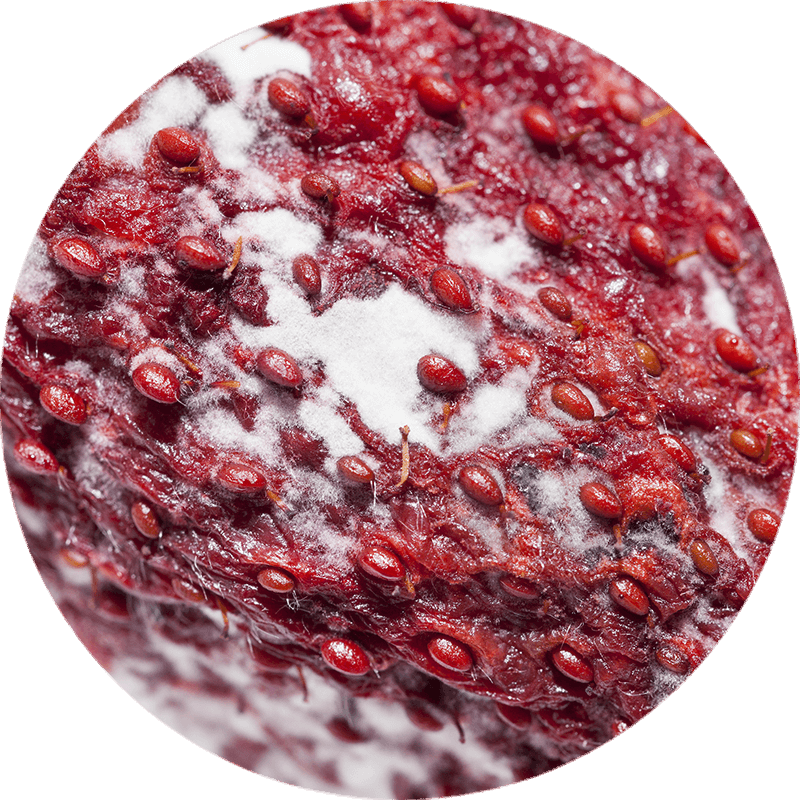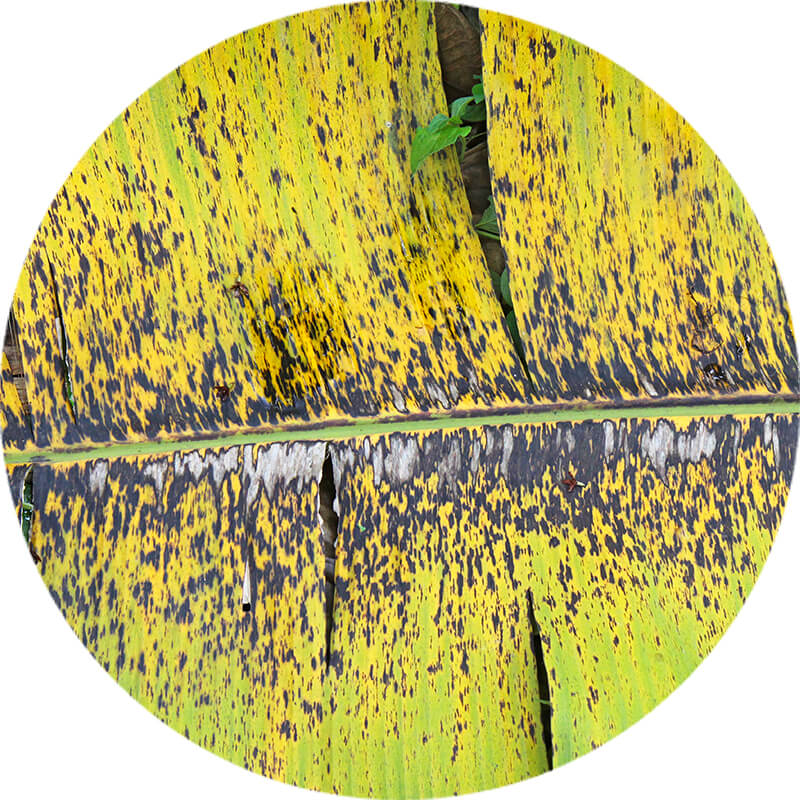
Grey rot - Botrytis cinérea
The genus Botrytis includes about 20 species, of which the most infectious is Botrytis cinerea. The diseases caused by this fungus are known as Grey Rot. It has a wide worldwide distribution, being able to infect more than 200 crops of economic importance including vine, berries, horticultural and ornamental, as well as in forest nurseries or postharvest. This aerial fungus is especially harmful in greenhouse crops that grow under high humidity conditions.
-
Symptoms
Symptoms of Botrytis cinerea can appear on leaves, fruits, root necks, stems, flowers, seeds, seedlings and, in general, on all parts of the plants except the roots. However, the symptoms are usually specific to the type of host. Despite this diversity, the most common in infections caused by Botrytis is the appearance of a characteristic grayish mantle on the affected tissues. Which can end up necrotizing infected tissues and causing the plant’s death, spreading the disease quickly to nearby plants.
It is not unusual to get cloud of spores when blowing dead tissues, releasing the spores that help the fungus to disperse.
-
Infection Cycle
The start of new infection cycles occurs when the climatic conditions are favorable, that is, moderate temperatures and high humidity. Botrytis is characterized by producing many spores, called conidia, on the tissues it affects. These give the characteristic appearance of gray mold and are the means of dispersal of the fungus through wind and rain causing new infections through open wounds. When conditions are no longer favorable to the fungus, new resistance structures, known as sclerotia, are formed. Thanks to these structures and mycelia, they persist in the soil or in dead tissues until new disease cycles occur.

Fusarium - F. solani y F. oxysporum
Many disiease causing species belong to the genus Fusarium in virtually all known crops. In this section, reference will be made primarily to F. solani and F. oxysporum, species that cause vascular wilt and rot of seedlings, root, crown and stem base.
This disease occurs virtually in all known areas of the world where some species are grown, causing significant economic losses by reducing the growth and production of crops.
Within the species F. oxysporum, there are special forms that, although morphologically similar, are specialized in specific plant species and not in others. Plants of the same family can therefore be infected by different special forms of the same species causing the disease known as Vascular Fusariosis.
-
Symptoms
It is difficult to determine which symptoms appear first. One of the first symptoms is the yellowing of the lower leaves, followed by wilting of the plant. It can result in the final death of the host before it even reaches maturity. In other organs of the plants, areas of soft rot appear that later turn brown and finally black.
With the progress of the disease, growth stops or slows, as well as the development of the fruits.
If we make a longitudinal cut of the stem, brown streaks appear along the vascular system. Sometimes this symptom is characteristic of the fungi that has cause the infection and can help make a diagnosis of the disease.
-
Disease cycle
These pathogens can remain in infected soils for up to 15 years thanks to the spores they produce, which in this case are called clamidospores, germinating again when the weather conditions are again optimal.
Fusarium wilt is a disease of temperate temperatures, preferably of acidic and clayey soils. When the soil temperature is optimal, the hyphae of the fungus extend until reaching the roots or lower areas of the stem without showing symptoms in the aerial part.
The entrance of Fusarium is made to the vascular system, from where it begins to spread throughout the plant collapsing and reducing the flow of water and nutrients.
The dispersion of the pathogen is carried out via seeds, cuttings, soil and infested work material or machinery.

Oidium
Oidium is a fungal group known as powdery mildew, which refers to the white-grayish dust that usually covers the affected tissues and is the characteristic sign of these diseases. They are obligate parasites or biotrophs. They are highly host specific. As a group, they infect many species of plants, including many trees and shrubs, numerous ornamental plants, vegetables, cereals, herbs and even weeds. However, the individual species of powdery mildew are very specific. The diseases are caused by different species of fungi grouped into six main genera in the order Erysiphales, an order that includes a single family, the Erysiphaceae, highlighting the genera Erysiphe, Leveillula, Microsphaera, Sphaerotheca, Podosphaera and Uncinula.
-
Life Cycle
These fungi reproduce by means of two types of spores: asexual spores called conidia and sexual spores called ascospores.
Ascospores are dispersed by wind and establish primary infection in young tissues. After infection, the pathogen colonizes the epidermal cells forming an external mycelium that produces the asexual phase (conidiophores and conidia) giving rise to the characteristic sign of the disease. Conidia disperse in the wind and establish secondary infections, which can be repeated causing secondary infection cycles. When environmental conditions or nutrition become unfavorable for growth, fungi change to the sexual phase, constituting the main survival form of the fungus, forming cleistothecia.
The cleistotecios carry in sacks called ascas. Oval sex spores, called ascospores, occur within the ascas, at the beginning of spring.
-
Symptoms
The main sign of powdery mildew are grayish-white powder spots on leaves, although it can also infect other parts of the plant and can cause distortion and growth retardation of buds, leaves, and flowers, and a brown coloration in the Fruit.
The type and severity of symptoms vary depending on the combination of species of powdery mildew and the species of host plants involved.

Phytophthora - Phytophthora spp.
The species of the genus Phytophthora cause a wide variety of serious diseases in different types of crops, whether horticultural, fruit, ornamental or woody. The best known species is P. infestans infecting potato and tomato plants, however, there are other equally virulent species such as P. capsici, P. cinnamomi or P. cactorum.
These fungi are soil pathogens that can survive in the soil in the form of oospores or in the form of mycelium on plant debris.
-
Symptoms
Some species infect few hosts while others can cause symptoms in many different kinds of crops.
The most common symptoms is rot of the root, stem base, tubers and fruits.
-
Disease cycle
Depending on the host, the life cycle or disease may have small variations. We will take as an example the cycle of P. capsici on cucurbitaceae. The fungus oospores in the soil are resistant to desiccation, low temperatures and extreme conditions, being able to survive in the absence of a host for several years. When the oospora germinates, it produces another type of spores with the ability to “swim” and float in water, which are dispersed by it until they reach the plant tissue. Once here, the fungus grows inside the plant tissues and emits out structures called sporangia that will contain the spores that will again be dispersed so that the disease spreads rapidly. When the cycle ends or the conditions are adverse, the fungus releases oospores to the soil to remain in the soil latent until the cycle starts again.

Black sigatoka - Mycosphaerella fijiensis
Black Sigatoka is a disease caused by the fungus Mycosphaerella fijiensis, which mainly attacks banana leaves. It is devastating under favorable weather conditions, where leaf necrosis can reduce yields around 35-50%.
-
Symptoms
The first symptoms of Black Sigatoka are very small chlorotic spots that usually appear on the third or fourth open leaf. These spots progress until the leaves show brown stripes delimited by the leaf nerves. As the disease progresses, these symptoms become more evident until the lesions of the characteristic leaves of the disease are caused. Adjacent tissue not yet colonized may appear wet, especially when it is under conditions of high humidity.
-
Infection Cycle
The cycle begins with the germination of the spores, which, after their release and dispersion by the action of water or wind, are deposited on healthy or infected leaves. Here, the inoculum germinates to produce a germinative tube that lengthens and branches rapidly in search of stomata, where the fungus will penetrate plant tissues. It is estimated that this process takes place in a time that goes from 2 to 6 hours. For this to happen, in addition, the presence of free water on the leaves is necessary. Once inside the leaf tissues, this fungus emits toxins that affect the physiology of the mesophyll cells and they enter a process of cell death. As a consequence of this process, the symptoms described above appear on the leaves that are characteristic of the disease.

Verticilosis - Verticillium spp.
Several species of the Verticillium genus cause significant economic losses by infecting crops of agricultural interest in temperate regions, including horticultural and annual, perennial or woody species.
These fungi can persist in the soil in the absence of their host for years in a dormant state. Once the weather conditions are favorable again and there is a nearby host, they can cause new infections through the roots.
-
Symptoms
The most common symptoms caused by Veticillium species are foliar chlorosis followed and wilting, followed by stem and root necrosis. However, new symptoms may appear depending on the host and be more evident in warmer times.
Resistance structures, visible and black, called microsclerocios, frequently appear in tissues with symptoms.
-
Mode of action
The development of verticilosis is favored by conditions of humidity and temperatures of 21-27º C. Under these conditions, the micro sclerosis’ are stimulated by the exudates of the roots to germinate. Next, the fungus penetrates the elongation zone, finally colonizing the root cortex. From here, the hyphae invade the xylem bundles and the rest of the vascular system of the plant causing it to collapse. In this way, water and nutrients cease to circulate correctly, observing the first symptoms of chlorosis and wilting in leaves. When the disease is advanced and necrotic tissues or dead plants appear, the fungus produces microsclerotia that return to the soil attached to them.
.png)
.png)




